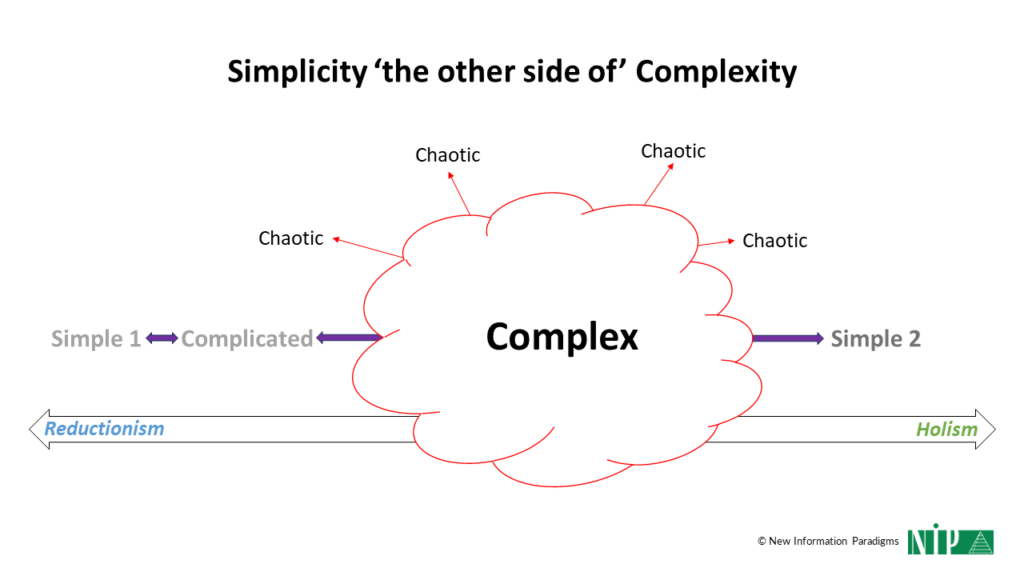Two Kinds of Simple: Which is Right?

We all seek simplicity. But does simplicity exist in a Complex world? It does, and there are two kinds. The first tries to reduce Complexity to simplicity; the second holistically embraces Complexity to achieve simplicity on the other side of it. Only the second works. In this article, we’ll find out why.
“Simplicity is the ultimate sophistication.”
Leonardo da Vinci
Human beings all seek simplicity.
Whether it’s Occam’s Razor in problem-solving, the KISS principle in systems design, or the streamlined and intuitive interfaces of our smart phones, simplicity is prized.
And rightly so.
Why make things any more difficult and involved than they need to be – especially in today’s Complex world?
The Two Kinds of Simple
But “need to be” is the key here, because the “simple” we want needs to work in our reality, and our reality is Complex.
(The amplifying and accelerating affect of information technology has made this Complex nature of reality even clearer, including by making the effects of Complexity far more acute.)
With Complexity in focus, we then recognise that there are two very different kinds of “simple”:
- Simple as a retreat from Complex – denying or failing to respond to the reality of Complexity, and assuming it can be controlled. We’ll call this Simple 1.
- Simple the other side of Complex – recognising, understanding and harnessing Complexity through simple-but-profound principles and practices. We’ll call this Simple 2.
Simple 1 and Simple 2 both satisfy the natural human “craving” for simplicity.
They superficially look the same, as they both involve a small set of assumptions about what the world is like, and a small set of approaches, models and “tools” to adopt as a result.
Opposite Ends of a Spectrum
However, Simple 1 and Simple 2 are completely different in their assumptions and in their practice, and – when adopted as the default “kind” of “simple” – yield completely different results.
This is because Simple 1 and Simple 2 are at opposite ends of a spectrum of perception and action:

Let’s review this spectrum in more detail:
- Simple 1 is all to do with things that are isolated, closed and – for lack of a better term – “easy”.
- Complicated is a “multiplication” of Simple 1: it’s where things are intricate and often very difficult, but where there they are stable, the parts of a whole can be fully understood, and everything can be disassembled and reassembled back into a whole with no loss of performance.
- Complex is where things are also intricate and difficult, but where there is a “fault line” in the spectrum such that it is in no way a “multiplication” of Complicated: change is constant, unpredictability is inherent, full understanding is impossible, the total is more than the sum of its parts, and there is the constant risk that things can collapse into chaos.
- Simple 2 is where the change and uncertainty of Complex are embraced with a small set of processes, patterns and models that can then be used to navigate them, but never to tame or “control” the situation.
The Two Kinds of Simple Reflect Reductionism and Holism
Crucial to understanding the spectrum are the opposed “pulls” of Reductionism and Holism, which characterise the very different “small set of assumptions about what the world is like” and “small set of approaches, models and “tools” to adopt as a result” that we mentioned earlier:
| Reductionism | Holism | |
|---|---|---|
| Approach | Analytical | Synthesis |
| Focus | Reduction of complex systems | Integration of complex systems |
| Method | Breaking down into simpler parts | Understanding the whole system |
| Perspective | Bottom-up | Top-down |
| Assumption | Whole is the sum of its parts | Whole is greater than the sum |
| Examples | Reduction of biological processes | Study of ecosystems |
| Benefits | Clear understanding of components | Comprehensive understanding |
| Limitations | Ignores emergent properties | Difficult to identify interactions |
| Application | Reductionist science | Systems thinking |
Reductionism and Holism are the two opposing “forces” that pull in different directions in response to Complexity – towards Simple 1 and Simple 2, respectively – but the “pulls” of these two “forces” isn’t equal, with the pull towards Reductionism being by far the stronger:
- Our brains naturally tend towards Reductionism.
- Reductionism is the main principle in all conventional management approaches.
- Until now, there hasn’t really been an alternative offered.
- Until relatively recently, it didn’t really look as if we needed one: things seemed to be working well enough.
Reductionism has therefore become our default, causing us to retreat from Complexity and double-down on Complicated (or even Simple 1) approaches:
- Developing more such approaches.
- Applying such approaches more forcefully.
What Defaulting to Reductionism Looks Like
We see this defaulting to Reductionism in the continued proliferation of legislation, regulation, standards, training, contracts, etc.
All of these seek to:
- Exert control to overcome challenges.
- Fully describe things.
- Break them into their constituent parts.
- Address each of them to solve the issues experienced in the whole.
Even the way that new technologies like Artificial Intelligence are put to use ultimately demonstrates a Reductionist “pull” towards Complicated and Simple 1.
Why? Because the challenge is ultimately seen as one of analysis to find a solution, again failing to understand that:
- Complexity defies analysis, understanding and “solution”.
- The major force behind Complexity is People, where human intelligence is needed in response.
Whichever way we turn, then, we are pursuing the Complicated and Simple 1, even though these are fundamentally out of step with Complex reality.
The results? The accelerating tide of missed targets, failed projects, struggling relationships and evaporating morale we see at every level.
Things aren’t just sub-optimal; we are making them worse.
What Happens When Embracing Holism
In contrast, just as Simple 1 involves a Reductionist set of assumptions and practices that pushes back against Complexity, Simple 2 involves a set of Holistic assumptions and practices that fully embraces it:
- Looking for recurring patterns.
- Considering the interaction of such patterns with other patterns and existing models.
- Integrating them or adjusting those patterns and models.
- Continuously responding to change by adapting.
And “behind” all these patterns, and at the heart of holistic models – shaping and responding to Complexity – are the Things That Matter: the foundation of Value Management:
- They are the “currency” of Value and they pragmatically embody purpose.
- They inspire, engage, motivate and mobilise People as individuals and groups.
- They promote and facilitate the natural emergence of cooperation and collaboration.
- They harness Complexity in times of turbulence, uncertainty and accelerating change.
Most of all, establishing, focusing-on and delivering-on the Things That Matter resists the “pull” towards Reductionism and Simple 1.
And that’s why the Things That Matter are the foundation of Value Management.
In Conclusion
As individuals and organisations, we therefore have a choice of two kinds of Simple in our pursuit of simplicity we all crave.
But only by pursuing Holism in our response to the undeniable and unavoidable Complexity of our world will we find the right kind of Simple.
This is Simple the other side of Complex.
It is the only way to resist the fatal drag and allure of Reductionism towards the wrong kind of Simple.
It is the only Simple that works.

